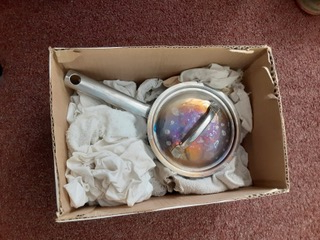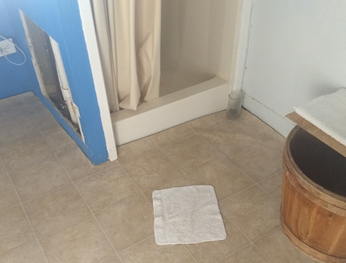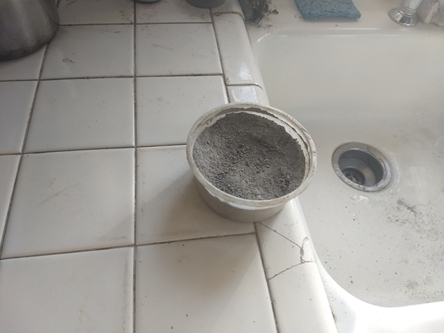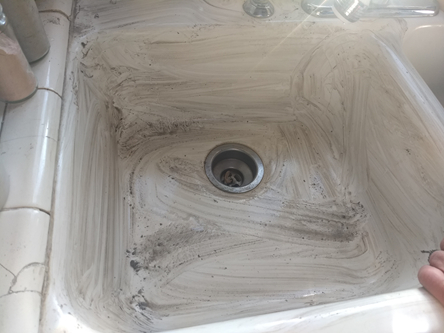
Home > Newsletters > GreenFriends Q3 2021 Newsletter
| Home | Source Reduction | Friends of Green Friends | Newsletters |
| Gardening | Resources | What You Can Do | Embracing The Trees |
| Reduce, Reuse, Recycle (In That Order) | ||
 George Wright |
||
|
When most of us think Reduce, Reuse, Recycle, we focus on the recycle part. George Wright, however, lives in the first two steps, going well beyond recycling by trying to think about things that never have to be consumed in the first place, leaving nothing to recycle. He places a greater emphasis on the Reduce and the Reuse part of the equation. In this lighthearted interview with fellow Santa Fe satsang member Vishwan, George explains some of the novel ways he saves energy, and reuses items in ways most of us have never even considered. |
||
|
GreenFriends: George, I understand that you like to recycle. Is that true?
George: Yes. GreenFriends: You’ve got to give us a little more elaborate answer than that, George. George: Yes. Well, actually, to me, recycling is the last step. It's my least favorite thing. Well, it's not the least favorite, but I think the most crucial is to reduce and reuse. Those are the two most important things. One thing I do in my kitchen, you can see here now, I use ash. I use ash that I have from my fireplace, and I have a little plastic container of it, even though I'm not supposed to use plastic, but still, there it is. GreenFriends: A little container? George: A little container of fireplace ash. So I'm just cleaning my sink with fireplace ash. GreenFriends: So it acts like a scrubbing agent? George: It acts as a scrubbing agent, and it's also extremely alkaline. So for instance, you'll never want to use it on your hair. Once, I tried it as a shampoo, and it's like, "Oh my God, my scalp was like filled with steel wool." It took everything out. So you don't want to do that. But the wonderful thing about the ash is that it's so alkaline. This rag that's in the dish there, this hasn't been washed in six or eight months, but the ash is so alkaline that nothing can grow on it. So really, it's antiseptic as well as cleaning. And you can use the ash to polish stainless steel and polish silver. What do you think? GreenFriends: It looks good. George: I just washed my sink with it. |
||
|
||
|
GreenFriends: Okay. Is there anything else you use ash for besides cleaning? Would you say you use it in a garden? George: Not in New Mexico, because...well, you can use some, but already, the soil is so alkaline. You don't want to add to it. GreenFriends: But in areas where the soil is more acid? George: Yeah, you could use it there. The Indian Pueblos used ash in their adobes. That's how they would recycle or reuse the ash. They would mix it in with the adobes when they were making them. And I think it would be a very good thing, because it's alkaline. It would prevent mold and things from growing. I'm a mischievous cook, so sometimes I put a little bit in the cakes I make. GreenFriends: In lieu of baking powder or what? George: No, I just add another element. Sometimes I put coffee grounds in, or I'll put some unbrewed tea in it. GreenFriends: I think we'll pass on this dessert that you have created for us. George: The other thing I'd like to describe is T-shirts. I get these T-shirts from Walmart, or Dillard's, and inevitably what happens, seems very quickly, I don't know why, but the back goes out, right under the back collar, and it all just disintegrates. So I cut the T-shirts up. I cut the sleeves off, and I cut the hard parts of the collar and the seams that are all bumpy. And then I make these rags like this, and then I just use them for wipers. GreenFriends: For what? Wipers? George: Instead of paper towels. There haven't been any paper towels ever in this house since I've lived here. So I wipe up the counter with it. And most of the time, it'll dry up and I'll reuse it again, and then I'll just throw it in the corner and put it in the laundry. And they're just so much more effective than paper towels and useful. So that is one of my loveliest, loveliest discoveries. And the other discovery is this hotbox. I'd been reading about hotboxes. They're made of wood and some kind of insulation, all this kind of stuff. And I said one day, "I'm never going to have the time to build one of these damn things with everything I've got to do." So I just found a box. GreenFriends: Please explain the idea behind the hotbox. George: The idea behind the hotbox is you put, say, Basmati rice, on the burner, you bring it to a boil, and then you take the pot and put it in a box like this, after it's brought to a boil for two or three or four minutes. Then you take this wooden box and you put it in so it fits nicely. It's got the cover on and all that. And I put all the rags around it, and the rags on top, like this. And then I cover it. And I do that at 8:30 or 9 in the morning, and then at lunchtime, I've got a pot of rice. GreenFriends: Fully cooked? George: Fully cooked. GreenFriends: You're putting a cutting board on the top? George: It could be any board. GreenFriends: Any board? George: Yeah. Even if you're bored with yourself, you can put that on top. . |
||
 Cardboard hotbox with basmati rice |
|
GreenFriends: (Eyes rolling) So you're saving energy, whether it's electricity for an electric stove, or gas for a gas stove, by only using a small amount of energy to get it started? George: Mm-hmm. And it's sweet. I think it's a gentler food in a way. Electricity or gas has that pulse to it. It's more sattvic in a way, and sweeter. Like Amma says, "Cook your own food, because then it's got your vibration, pure vibration." There's a story about a guy in India who was possessed by this idea to read newspapers. And he's like, "Where is this coming from?" It turned out the guy who was cooking his food was reading a newspaper as he was cooking. Then it goes into the food. GreenFriends: So when you're cooking the food this way by putting it in a box and leaving it alone, then there's no vibes going into it? George: Yeah, right. Well, maybe the vibes of the house. GreenFriends: Well, it's kind of neutral, I mean, it's not being directly affected by the cook. George: Right. GreenFriends: Okay, George. So you get the ash from the fireplace. Tell us about how you heat your house. George: Well, in the winter, I do have a gas heater in the living room, which I turn on in the morning, just to take the edge off the chill while I'm doing the meditation and so forth. And then I shut it off when I'm out working in the day. In the evening I use the fireplace. I have a nice fireplace and I make a blazing fire in front of that. And then I do yoga or I read in front of it and it's just totally delightful. The treat of a fire at the end of the day makes a goal so I don't mind the cold so much. But furthermore, I've discovered that I could train myself to not mind the cold. I could feel cold, or I could feel chilled, and I could distinguish the kind of chill that would lead to illness and the kind of chill that would just be like I'm chilly. I wouldn't mind being chilly. Somebody told me that's a good way to stimulate your immune system, to be a little bit cold. And also the lower temperature is better for your lungs rather than even 60 or 65. This house can be in the 40s. Sometimes going down in the upper 30s. But it gives me a feeling of self-confidence, if we were to arrive at a time where there's no gas or no electricity, or something went down, I could survive, and be, and happily. Part of the way of doing it is to dress properly. In the middle of winter, I have long johns that are silk. Over that I'll have long johns that are smart wool, Merino wool. Over that, I'll have a final shirt and over that, I'll have a sweater and over that, I'll have another sweater and then I'll have a coat or a down jacket, so I can live comfortably. I'm a little bit muffled up about clothing, but it's wonderful. GreenFriends: This is actually what a lot of people had to do recently during the ice storm in Texas. George: Exactly. The other thing that I do that I think is really a wonderful discovery is all my clothing goes out into the sunshine every morning. The long underwear, the silk, the wool, the pants, everything goes out. The pillows from the bed, sometimes the top sheet, and they're all cooking in the sun. GreenFriends: And what are you saving by doing that? George: I don't have to wash so much. I mean the silks, the winter silk, the silk underwear and the smart wools will maybe be washed two times in the winter. Probably I wouldn't even need to do that because they're refreshed. Silk and wool doesn't hold odor, cotton does. Cotton definitely holds odor. Silk and wool doesn't, so you save the normal things on laundry. GreenFriends: So you're saving water and you're saving the energy to heat that water. George: Yeah. Furthermore, the clothes that have been put out there, smell almost like freshly-washed clothes. They have that sun kind of scent to them. And then sometimes I'll put my clothes out, well, we don't get rain so much here in New Mexico, but I'll put them out before the rain, because then they'll get an extra rinse. GreenFriends: And your clothes smell so good that you don't have to take a shower, right? George: Right. And then even the wind, I love the wind because the wind blows through the clothes. It's like blowing the clothes out. Something refreshes them. I don't know if it's true, but poetically, it seems like that's true. And it's just, I don't know, it's just so lovely. It's just so completely lovely to live like that. Sometimes in the wintertime I'll go in, and I have some rose oil, and I'll be under the sheets that have just been outside and all smelling fresh with the sun. And I'll put a little rose oil on each of my wrists. And then I'll fall off to sleep and I'm smelling roses and fresh laundry sheets. It's like Holy Mary, Mother of God has suddenly appeared. GreenFriends: It sounds like a different spin on both wind power and solar power. We're taking advantage of both of those things. You're not generating electricity, you're avoiding the use of electricity. George: Also it's in the garden. All the clothes are being dried in the garden. There's rosemary; there's mint; there's oregano; there's chives; there's chard. All these different kinds of aromatic things. It's all giving us subtle incense. And don't forget the moon. You have the moon. Sometimes I leave the things out, and they're getting moonlight. It's a subtle thing, but it's there. This morning I was just about to get out of the shower and I realized that the little hand towel I use as a bathmat was gone. I looked around and saw a washcloth and I used it for a bathmat. It was perfect! My two bare feet barely fit on it, but they did! |
 Wash cloth shower mat |
| My usual "hand towel bathmat" is about 12 in. by 18 in. (216 sq. in.) - much smaller than a more standard sized bath mat which is about 2 ft. by 3 ft. (864 sq. in.) That is four times the size of mine. This morning’s discovery opened new dimensions of "frugal Reduce".
And even better, eliminate the bathmat altogether! Enjoy the experience of cold feet bottoms shivering spineward. Furthermore, as far as towels go, I use a 20 in. by 40 in. (800 sq. in.) white "gym" towel, like the ones you get at the gym. Regular size bath towels are about 2 ft. by 4 ft. (1152 sq. in.), about 50% larger. Downsizing to smaller towels can save 50% on laundry costs. The Japanese have small bath towels. Here is one that measures 13 in. by 34 in. (442 sq. in.)! Not only is it small, it is thin - the thickness of a cotton sheet! Yikes! Some of the more luxurious Japanese bath towels are made of terrycloth, but it is the thinnest terry cloth that I have ever seen. I can almost dry my average size 5' 5', 150 lb. frame. I must wring out the towel several times and there is still a layer of moisture on the skin, which quickly evaporates. I can do the same job with a 12 in. by 12 in. US washcloth. Easier to do in warmer summer temperatures |
 Japanese bath towel |
|
This sensibility, to me, is the essence of Reduce. It's an interesting, fun game – finding ways to economize, looking with fresh eyes, what is really needed – essential. Shraddha all over the place! Read about Kabir's GreenFriends journey in the Q3 2021 newsletter >> |
| Home | Source Reduction | Friends of Green Friends | Newsletters | Resources | What You Can Do | Embracing The Trees |
For more information, e-mail info@greenfriendsna.org |
||||||

